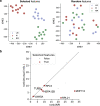Identification of VWA5A as a novel biomarker for inhibiting metastasis in breast cancer by machine-learning based protein prioritization
- PMID: 38291227
- PMCID: PMC10828438
- DOI: 10.1038/s41598-024-53015-1
Identification of VWA5A as a novel biomarker for inhibiting metastasis in breast cancer by machine-learning based protein prioritization
Abstract
Distant metastasis is the leading cause of death in breast cancer (BC). The timing of distant metastasis differs according to subtypes of BCs and there is a need for identification of biomarkers for the prediction of early and late metastasis. To identify biomarker candidates whose abundance level can discriminate metastasis types, we performed a high-throughput proteomics assay using tissue samples from BCs with no metastasis, late metastasis, and early metastasis, processed data with machine learning-based feature selection, and found that low VWA5A could be responsible for shorter duration of metastasis-free interval. Low expression of VWA5A gene in METABRIC cohort was associated with poor survival in BCs, especially in hormone receptor (HR)-positive BCs. In-vitro experiments confirmed tumor suppressive effect of VWA5A on BCs in HR+ and triple-negative BC cell lines. We found that expression of VWA5A can be assessed by immunohistochemistry (IHC) on archival tissue samples. Decreasing nuclear expression of VWA5A was significantly associated with advanced T stage and lymphatic invasion in consecutive BCs of all subtypes. We discovered lower expression of VWA5A as the potential biomarker for metastasis-prone BCs, and our results support the clinical utility of VWA5A IHC, as an adjunctive tools for prognostication of BCs.
© 2024. The Author(s).
Conflict of interest statement
Jiwon Koh and Han Suk Ryu report receiving consultation fees from DCGen. Co., Ltd. Han Suk Ryu and Soo Young Park are the Board of Directors of Pharmonoid Co., Ltd. The authors declare that the research was conducted in the absence of any commercial or financial relationships that could be construed as a potential conflict of interest.
Figures





References
MeSH terms
Substances
Grants and funding
LinkOut - more resources
Full Text Sources
Medical
Molecular Biology Databases

